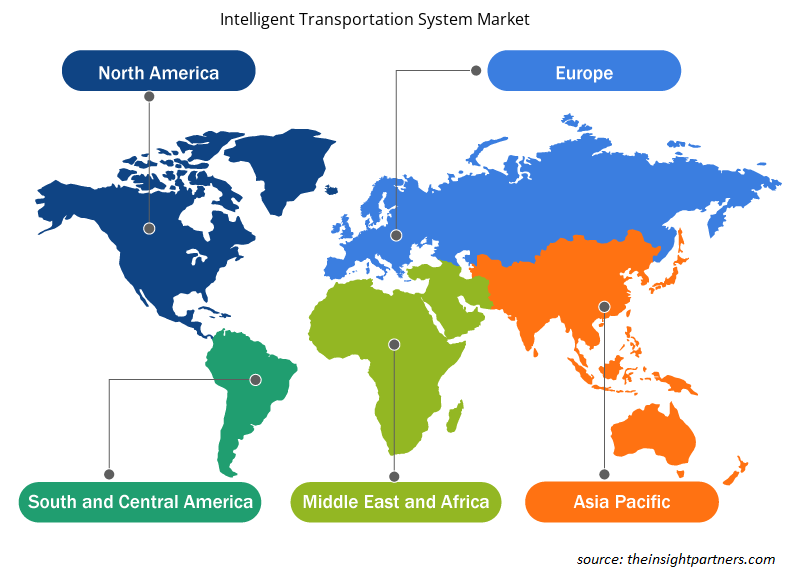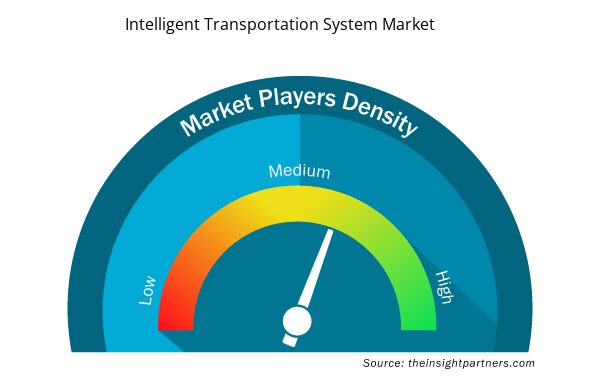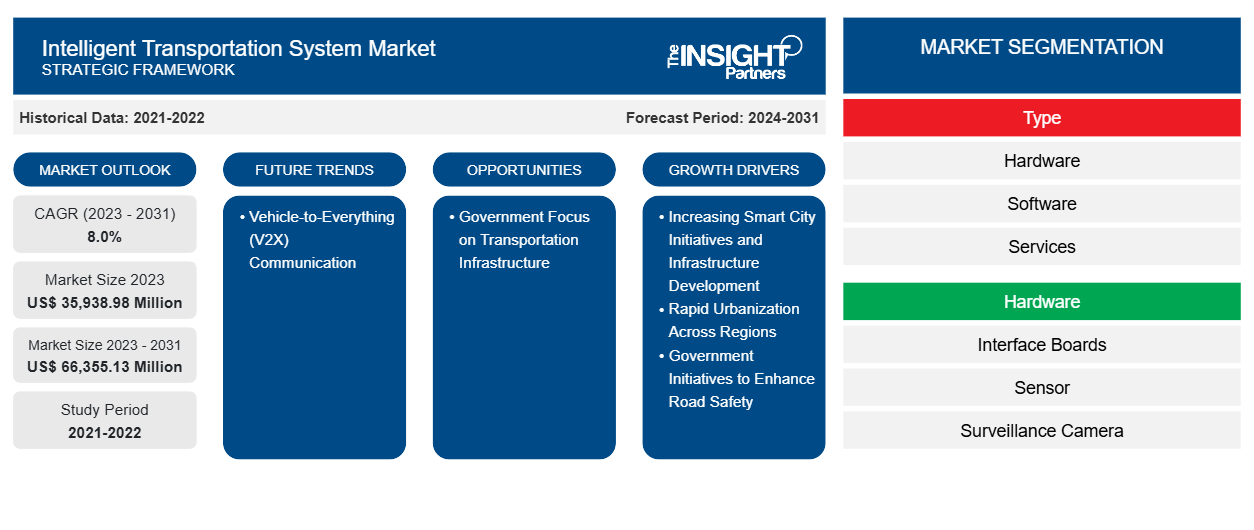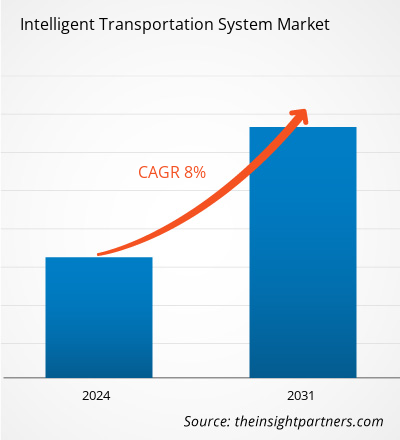지능형 교통 시스템 시장 규모는 2023년 35,938.98백만 달러에서 2031년까지 66,355.13백만 달러에 도달할 것으로 예상됩니다. 이 시장은 2023-2031년 동안 8.0%의 CAGR을 기록할 것으로 예상됩니다. 지능형 교통 시스템을 위한 V2X 구현은 예측 기간 동안 새로운 트렌드로 부상할 가능성이 높습니다.
지능형 교통 시스템 시장 분석
도로(도시 인프라의 중요한 구성 요소)는 인간의 이동성과 물류를 용이하게 하고, 사회 및 경제 성장의 기반이 되며, 도시, 항구, 공항을 연결합니다. 도로 유지 관리 및 개발은 경제 성장을 촉진하지만, 교통량 증가는 과밀화 및 교통사고와 같은 문제로 이어집니다. 차량 소유 증가의 부정적인 결과는 최근 몇 년 동안 더 심해졌습니다. 이는 온실 가스 배출로 인한 도로 교통 사고와 환경 파괴가 크게 증가하게 되었습니다. 교통 관리 및 인프라를 개선하기 위해 ITS는 유선 및 무선 연결을 기반으로 하는 광범위한 ICT를 사용합니다. 이는 운송 위험을 낮추고, 교통 체증을 완화하고, 운송 효율성을 높이고, 오염을 줄이며, 운전 경험, 도로 시스템 안전 및 용량을 향상시킵니다. 최첨단 통신 기술을 운송 인프라 및 차량에 통합함으로써 ITS는 생산성을 높이고, 운송의 이동성과 안전을 개선하며, 글로벌 연결을 강화합니다. 따라서 ITS에 대한 수요는 앞으로 몇 년 동안 증가할 것으로 예상됩니다. 지능형 교통 시스템(ITS) 시장은 주로 스마트 시티 이니셔티브와 인프라 개발 증가, 지역 전체의 급속한 도시화, 도로 안전을 강화하기 위한 정부 이니셔티브에 의해 주도됩니다. 또한, 교통 인프라를 개선하기 위한 정부 기관의 초점은 예측 기간 동안 시장에서 수익성 있는 기회를 창출할 것으로 예상됩니다. 그러나 시스템 통합 과제, 사이버 보안 위협, 높은 유지 관리 비용은 시장 성장을 방해하는 요인입니다.
지능형 교통 시스템 시장 개요
지능형 교통 시스템은 최첨단 무선, 전자 및 자동화 기술을 사용하여 교통 네트워크를 모니터링, 평가 및 제어합니다. 이들은 정보 통신 기술(ICT)을 사용하여 자동차와 교통 인프라를 연결합니다. 따라서 무선 장치, 센서 기술 및 스마트 ICT 서비스의 이점은 ITS 채택의 급증으로 이어졌습니다. 또한 ITS는 통행료, 상업용 차량 운영, 교통 운영, 여행자 정보 및 대중 교통에서 교통 흐름을 개선하고 충돌을 방지하며 승객의 편안함과 안전을 강화하는 데 수많은 응용 프로그램을 가지고 있습니다.
귀하의 요구 사항에 맞게 이 보고서를 사용자 정의하세요
이 보고서의 일부 또는 국가 수준 분석, Excel 데이터 팩을 포함하여 모든 보고서에 대한 사용자 정의를 무료로 받을 수 있으며 신생 기업 및 대학을 위한 훌륭한 혜택과 할인 혜택을 이용할 수 있습니다.
- 이 보고서의 주요 시장 동향을 알아보세요.이 무료 샘플에는 시장 동향부터 추정 및 예측까지 다양한 데이터 분석이 포함됩니다.
지능형 교통 시스템 시장 동인 및 기회
지역 전체의 급속한 도시화로 시장 성장 촉진
기존의 교통 인프라는 자원 배분, 오염 제어, 교통 체증 측면에서 비효율적이라고 인식됩니다. 통근 교통량과 차량 소유의 증가는 지능형 솔루션과 개선된 교통 관리 기술에 대한 지속적인 수요를 생성합니다. ITS는 자동 주차, 스마트 신호등, 실시간 대중 교통 추적을 지원합니다. 교통 관리는 도시 계획 및 개발의 중요한 측면입니다. 유엔 유럽 경제 위원회(UNECE)에 따르면 2050년까지 세계 인구의 55%가 도시 지역에 거주할 것으로 예상됩니다. 또한 세계은행에 따르면 현재 세계 인구의 56%, 즉 44억 명이 도시에 거주하고 있습니다. 이러한 추세는 계속될 것으로 예상되며 2050년까지 도시 인구는 새로운 정점에 도달하여 10명 중 7명이 도시에 거주할 수 있습니다. 도시가 세계 GDP의 80% 이상을 창출한다는 점을 감안할 때 잘 관리된 도시화는 생산성을 높여 지속 가능한 성장을 촉진할 수 있습니다. 따라서 도시 확장 및 개발은 지능형 교통 시스템 시장 성장을 촉진합니다.
정부의 교통 인프라에 대한 집중
전 세계적으로 지하철 시설, 신공항, 철도망 건설이 증가 하고 있습니다. 2023년 3월, 캐나다 켈로나 시의회는 켈로나 공항 터미널 확장 프로젝트에 9,000만 달러의 자금을 승인했습니다. 2023년 현재 미국에서 6개의 신공항이 건설 중입니다. 2022년 인도 정부는 2025년 말까지 220개의 공항을 건설할 계획을 발표했습니다. 2023년 인도 정부는 연결성을 강화하기 위한 7개의 혁신적인 철도 프로젝트에 39억 3,000만 달러를 승인했습니다. 2021년 11월, 미국 의회는 1,100억 달러를 투자하여 전국의 도로와 교량을 수리하고 재건하는 양당 인프라 협정을 통과시켰습니다. 기후 변화 완화, 회복력, 형평성, 모든 사용자의 안전에 초점을 맞춤으로써, 이 투자는 향후 5년 동안 국가의 열악한 도로와 고속도로를 혁신하는 데 맞춰집니다. 2023년 3월 미국 대통령과 캐나다 총리의 공동 성명에 따르면, 캐나다 중요 광물 인프라 기금에 따라 약 10억 9천만 미국 달러(15억 캐나다 달러)가 청정 에너지 및 교통 인프라 프로젝트를 지원하는 데 투자될 예정입니다. 따라서 전 세계적으로 성장하는 인프라 개발 프로젝트는 예측 기간 동안 ITS 시장 성장에 수익성 있는 기회를 창출할 것으로 예상됩니다.
지능형 교통 시스템 시장 보고서 세분화 분석
지능형 교통 시스템 시장 분석에 기여한 주요 세그먼트는 유형, 시스템, 응용 프로그램입니다.
- 지능형 교통 시스템 시장은 유형에 따라 하드웨어, 소프트웨어, 서비스로 세분화됩니다. 하드웨어 부문은 2023년에 가장 큰 시장 점유율을 차지했습니다. 하드웨어 범주는 인터페이스 보드, 센서, 감시 카메라, 통신 네트워크, 모니터링 및 감지 시스템 등으로 세분화됩니다.
- 시스템을 기준으로 지능형 교통 시스템 시장은 고급 교통 관리 시스템(ATMS), 고급 여행자 정보 시스템(ATIS), ITS 지원 교통 요금 시스템(ITPS), 고급 대중 교통 시스템(ATPS), 상업용 차량 운영(CVO) 등으로 세분화됩니다. 고급 교통 관리 시스템(ATMS) 부문은 2023년에 가장 큰 시장 점유율을 차지했습니다.
- 응용 프로그램을 기준으로 시장은 차량 관리 및 자산 모니터링, 지능형 교통 제어, 스마트 티켓팅, 가변 교통 메시지 표지판, 충돌 방지 등으로 구분됩니다. 지능형 교통 제어 부문은 2023년에 시장에서 가장 큰 점유율을 차지했습니다.
지리별 지능형 교통 시스템 시장 점유율 분석
지능형 교통 시스템 시장 보고서의 지리적 범위는 주로 북미, 아시아 태평양, 유럽, 중동 및 아프리카, 남미 및 중미의 5개 지역으로 나뉩니다. 유럽은 글로벌 지능형 교통 시스템 시장에 두 번째로 큰 기여자이며, 그 다음은 아시아 태평양입니다. 이 지역의 정부 기관은 스마트 모빌리티와 ITS 구현에 중점을 두고 있습니다. 예를 들어, 2023년 10월, EU에서 디지털 전환과 보다 스마트한 모빌리티를 가속화하기 위해 이사회는 2010년 지침을 개정하여 ITS 배포를 위한 새로운 프레임워크를 채택했습니다. 자동화 및 커넥티드 모빌리티, 주문형 모빌리티 앱, 멀티모달 교통과 같은 기술 발전은 모두 업데이트된 지침에서 고려되도록 의도되었습니다. 또한 상호 운용성을 개선하고 내비게이션 및 멀티모달 여행 플래너를 지원하는 디지털 데이터의 가용성을 가속화하고자 합니다. 이를 통해 자동차와 도로 인프라 간의 통신을 통해 운전자에게 앞의 교통 병목 현상과 같은 예상치 못한 상황을 경고할 수 있습니다. 2022년 6월 2일, 이사회는 이 제안에 대한 일반적인 입장을 채택했습니다. 2023년 6월 9일, 유럽 의회와의 기관 간 논의를 거쳐 새로운 지침의 언어에 대한 임시 합의가 이루어졌습니다.
지능형 교통 시스템 시장 지역 통찰력
Insight Partners의 분석가들은 예측 기간 동안 지능형 교통 시스템 시장에 영향을 미치는 지역적 추세와 요인을 철저히 설명했습니다. 이 섹션에서는 북미, 유럽, 아시아 태평양, 중동 및 아프리카, 남미 및 중미의 지능형 교통 시스템 시장 세그먼트와 지리에 대해서도 설명합니다.

- 지능형 교통 시스템 시장을 위한 지역별 특정 데이터 얻기
지능형 교통 시스템 시장 보고서 범위
| 보고서 속성 | 세부 |
|---|---|
| 2023년 시장 규모 | 35,938.98백만 달러 |
| 2031년까지 시장 규모 | 66,355.13백만 달러 |
| 글로벌 CAGR (2023-2031) | 8.0% |
| 역사적 데이터 | 2021-2022 |
| 예측 기간 | 2024-2031 |
| 다루는 세그먼트 | 유형별로
|
| 포함된 지역 및 국가 | 북아메리카
|
| 시장 선도 기업 및 주요 회사 프로필 |
|
지능형 교통 시스템 시장 참여자 밀도: 비즈니스 역학에 미치는 영향 이해
지능형 교통 시스템 시장은 소비자 선호도의 변화, 기술 발전, 제품의 이점에 대한 인식 증가와 같은 요인으로 인해 최종 사용자 수요가 증가함에 따라 빠르게 성장하고 있습니다. 수요가 증가함에 따라 기업은 제품을 확장하고, 소비자의 요구를 충족하기 위해 혁신하고, 새로운 트렌드를 활용하여 시장 성장을 더욱 촉진하고 있습니다.
시장 참여자 밀도는 특정 시장이나 산업 내에서 운영되는 회사나 기업의 분포를 말합니다. 주어진 시장 공간에 얼마나 많은 경쟁자(시장 참여자)가 존재하는지 그 규모나 총 시장 가치에 비해 나타냅니다.
지능형 교통 시스템 시장에서 운영되는 주요 회사는 다음과 같습니다.
- 히타치
- 지멘스
- 덴소
- 시스코 시스템즈 주식회사
- 인드라 시스테마스 SA
- 에프콘 GmbH
면책 조항 : 위에 나열된 회사는 어떤 특별한 순서에 따라 순위가 매겨지지 않았습니다.

- 지능형 교통 시스템 시장 주요 주요 업체 개요를 알아보세요
지능형 교통 시스템 시장 뉴스 및 최근 개발
지능형 교통 시스템 시장은 1차 및 2차 조사 이후의 질적, 양적 데이터를 수집하여 평가합니다. 여기에는 중요한 기업 간행물, 협회 데이터, 데이터베이스가 포함됩니다. 지능형 교통 시스템 시장의 몇 가지 개발 사항은 다음과 같습니다.
위치 기술 전문 기업인 톰톰(TOM2)은 Microsoft와의 협력을 심화하고 확대한다고 발표했습니다. 톰톰의 지도와 교통 데이터는 Microsoft 솔루션 전반에 걸쳐 위치 기반 서비스를 제공하여 매일 수억 명의 사람과 조직에 도달합니다. 이 두 회사는 AI가 주입된 제품을 포함하여 혁신을 시장에 출시하기 위해 긴밀히 협력할 것입니다. 또한 톰톰은 Microsoft Azure를 선호하는 클라우드 공급업체로 재확인하고 있습니다. (출처: 톰톰, 보도자료, 2024년 7월)
Kapsch TrafficCom의 자동 번호판 인식(ANPR) 소프트웨어는 최근 큰 업데이트를 받았습니다. 애플리케이션에 따라 업데이트는 자동 번호판 인식에서 최고의 성능을 달성할 수 있습니다. 새로운 ANPR 소프트웨어를 통해 인공 지능 소프트웨어는 GDPR을 준수하는 방식으로 수십만 장의 사진을 사용하여 번호판을 정확하고 안정적으로 감지하도록 훈련되었습니다. 이는 교통 체증을 일으키지 않고 차량을 식별하는 데 도움이 될 것입니다. (출처: Kapsch TrafficCom, 보도 자료, 2023년 4월)
지능형 교통 시스템 시장 보고서 범위 및 제공물
"지능형 교통 시스템 시장 규모 및 예측(2021-2031)" 보고서는 아래 영역을 포괄하는 시장에 대한 자세한 분석을 제공합니다.
- 범위에 포함된 모든 주요 시장 세그먼트에 대한 글로벌, 지역 및 국가 수준의 지능형 교통 시스템 시장 규모 및 예측
- 지능형 교통 시스템 시장 동향 및 운전자, 제지장치, 주요 기회와 같은 시장 역학
- 자세한 PEST 및 SWOT 분석
- 주요 시장 동향, 글로벌 및 지역 프레임워크, 주요 업체, 규정 및 최근 시장 개발 사항을 포괄하는 지능형 교통 시스템 시장 분석
- 시장 집중도, 히트맵 분석, 유명 업체 및 지능형 교통 시스템 시장의 최근 개발 사항을 포함하는 산업 환경 및 경쟁 분석
- 자세한 회사 프로필
- 역사적 분석(2년), 기준 연도, CAGR을 포함한 예측(7년)
- PEST 및 SWOT 분석
- 시장 규모 가치/양 - 글로벌, 지역, 국가
- 산업 및 경쟁 환경
- Excel 데이터 세트


- Microplate Reader Market
- Pharmacovigilance and Drug Safety Software Market
- Military Rubber Tracks Market
- HVAC Sensors Market
- Cell Line Development Market
- Procedure Trays Market
- Machine Condition Monitoring Market
- Photo Editing Software Market
- Artwork Management Software Market
- Medical Devices Market

Report Coverage
Revenue forecast, Company Analysis, Industry landscape, Growth factors, and Trends

Segment Covered
This text is related
to segments covered.

Regional Scope
North America, Europe, Asia Pacific, Middle East & Africa, South & Central America

Country Scope
This text is related
to country scope.
자주 묻는 질문
Asia Pacific is anticipated to grow at the fastest CAGR over the forecast period.
The key players operating in the intelligent transportation system market include Hitachi; Siemens; DENSO; Cisco Systems, Inc.; INDRA SISTEMAS; SA; EFKON GmbH; Cubic Transportation Systems, Inc.; Kapsch TrafficCom AG; TomTom International BV.; and Teledyne FLIR LLC.
Modern wireless networks connect cars, pedestrians, infrastructure, highways, etc., using cutting-edge communication technology. In the framework of intelligent transportation systems, vehicle-to-everything (V2X) communication supports a wide range of use cases, including entertainment services, cooperative autonomous driving (traffic information exchange), and traffic safety (traffic jam/accident reporting, collision warning, and collision avoidance).
The intelligent transportation system market was estimated to be valued at US$ 35,938.98 million in 2023 and is anticipated to grow at a CAGR of 8.0% over the forecast period.
Traditional transportation infrastructure is perceived to be inefficient in resource allocation, pollution control, and traffic congestion. The increase in commuter traffic and vehicle ownership generates a persistent need for intelligent solutions and improved traffic management techniques. ITS aids in automated parking, smart traffic lights, and real-time public transport tracking. Transportation management is an important aspect of urban planning and development. According to the United Nations Economic Commission for Europe (UNECE), by 2050, 55% of the world's population is expected to live in urban areas.
The hardware segment led the intelligent transportation system market with a significant share in 2023.
The intelligent transportation system market is expected to reach US$ 66,355.13 million by 2031.
Trends and growth analysis reports related to Technology, Media and Telecommunications : READ MORE..
The List of Companies - Intelligent Transportation System Market
- Hitachi
- Siemens
- DENSO
- Cisco Systems, Inc.
- INDRA SISTEMAS SA
- EFKON GmbH
- Cubic Transportation Systems, Inc.
- Kapsch TrafficCom AG
- TomTom International BV
- Teledyne FLIR LLC
The Insight Partners performs research in 4 major stages: Data Collection & Secondary Research, Primary Research, Data Analysis and Data Triangulation & Final Review.
- Data Collection and Secondary Research:
As a market research and consulting firm operating from a decade, we have published and advised several client across the globe. First step for any study will start with an assessment of currently available data and insights from existing reports. Further, historical and current market information is collected from Investor Presentations, Annual Reports, SEC Filings, etc., and other information related to company’s performance and market positioning are gathered from Paid Databases (Factiva, Hoovers, and Reuters) and various other publications available in public domain.
Several associations trade associates, technical forums, institutes, societies and organization are accessed to gain technical as well as market related insights through their publications such as research papers, blogs and press releases related to the studies are referred to get cues about the market. Further, white papers, journals, magazines, and other news articles published in last 3 years are scrutinized and analyzed to understand the current market trends.
- Primary Research:
The primarily interview analysis comprise of data obtained from industry participants interview and answers to survey questions gathered by in-house primary team.
For primary research, interviews are conducted with industry experts/CEOs/Marketing Managers/VPs/Subject Matter Experts from both demand and supply side to get a 360-degree view of the market. The primary team conducts several interviews based on the complexity of the markets to understand the various market trends and dynamics which makes research more credible and precise.
A typical research interview fulfils the following functions:
- Provides first-hand information on the market size, market trends, growth trends, competitive landscape, and outlook
- Validates and strengthens in-house secondary research findings
- Develops the analysis team’s expertise and market understanding
Primary research involves email interactions and telephone interviews for each market, category, segment, and sub-segment across geographies. The participants who typically take part in such a process include, but are not limited to:
- Industry participants: VPs, business development managers, market intelligence managers and national sales managers
- Outside experts: Valuation experts, research analysts and key opinion leaders specializing in the electronics and semiconductor industry.
Below is the breakup of our primary respondents by company, designation, and region:

Once we receive the confirmation from primary research sources or primary respondents, we finalize the base year market estimation and forecast the data as per the macroeconomic and microeconomic factors assessed during data collection.
- Data Analysis:
Once data is validated through both secondary as well as primary respondents, we finalize the market estimations by hypothesis formulation and factor analysis at regional and country level.
- Macro-Economic Factor Analysis:
We analyse macroeconomic indicators such the gross domestic product (GDP), increase in the demand for goods and services across industries, technological advancement, regional economic growth, governmental policies, the influence of COVID-19, PEST analysis, and other aspects. This analysis aids in setting benchmarks for various nations/regions and approximating market splits. Additionally, the general trend of the aforementioned components aid in determining the market's development possibilities.
- Country Level Data:
Various factors that are especially aligned to the country are taken into account to determine the market size for a certain area and country, including the presence of vendors, such as headquarters and offices, the country's GDP, demand patterns, and industry growth. To comprehend the market dynamics for the nation, a number of growth variables, inhibitors, application areas, and current market trends are researched. The aforementioned elements aid in determining the country's overall market's growth potential.
- Company Profile:
The “Table of Contents” is formulated by listing and analyzing more than 25 - 30 companies operating in the market ecosystem across geographies. However, we profile only 10 companies as a standard practice in our syndicate reports. These 10 companies comprise leading, emerging, and regional players. Nonetheless, our analysis is not restricted to the 10 listed companies, we also analyze other companies present in the market to develop a holistic view and understand the prevailing trends. The “Company Profiles” section in the report covers key facts, business description, products & services, financial information, SWOT analysis, and key developments. The financial information presented is extracted from the annual reports and official documents of the publicly listed companies. Upon collecting the information for the sections of respective companies, we verify them via various primary sources and then compile the data in respective company profiles. The company level information helps us in deriving the base number as well as in forecasting the market size.
- Developing Base Number:
Aggregation of sales statistics (2020-2022) and macro-economic factor, and other secondary and primary research insights are utilized to arrive at base number and related market shares for 2022. The data gaps are identified in this step and relevant market data is analyzed, collected from paid primary interviews or databases. On finalizing the base year market size, forecasts are developed on the basis of macro-economic, industry and market growth factors and company level analysis.
- Data Triangulation and Final Review:
The market findings and base year market size calculations are validated from supply as well as demand side. Demand side validations are based on macro-economic factor analysis and benchmarks for respective regions and countries. In case of supply side validations, revenues of major companies are estimated (in case not available) based on industry benchmark, approximate number of employees, product portfolio, and primary interviews revenues are gathered. Further revenue from target product/service segment is assessed to avoid overshooting of market statistics. In case of heavy deviations between supply and demand side values, all thes steps are repeated to achieve synchronization.
We follow an iterative model, wherein we share our research findings with Subject Matter Experts (SME’s) and Key Opinion Leaders (KOLs) until consensus view of the market is not formulated – this model negates any drastic deviation in the opinions of experts. Only validated and universally acceptable research findings are quoted in our reports.
We have important check points that we use to validate our research findings – which we call – data triangulation, where we validate the information, we generate from secondary sources with primary interviews and then we re-validate with our internal data bases and Subject matter experts. This comprehensive model enables us to deliver high quality, reliable data in shortest possible time.


 이 보고서에 대한 무료 샘플을 받으세요
이 보고서에 대한 무료 샘플을 받으세요